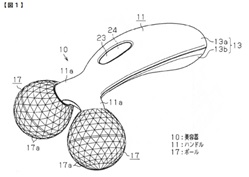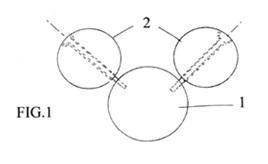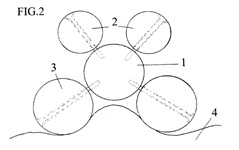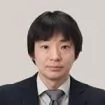"Reasoning" and "Teaching Away" Considered in Determination of Inventive Step of an Invention Regarding Cosmetic Instrument - Revocation Action against the Japan Patent Office (JPO) Decision of Invalidation Trial
Different countries have a different approach for determining inventive step of an invention. In Japan's case, four steps are applied when making the determination; [Step 1] Determination of identical features and differences; [Step 2] Consideration of Reasoning; [Step 3] Advantageous effect: [Step 4] Teaching Away. This article focuses on how "[Step 1] Determination of identical features and differences", "[Step 2] Consideration of Reasoning" and "[Step 4] Teaching Away" in the determination of inventive step have affected the decision of the Intellectual Property High Court (IPHC) case.
Outline of the Case and Case History
Japanese Patent Registration Number: 5356625
Patentee: MTG Co., Ltd.
Invalidation Trial Number: 2019-800058
IPHC Court Case Number: 2021(Gyo-ke)10115
The patentee filed a lawsuit at the IPHC for revocation against a decision of invalidation trial of the JPO against their patent right (hereafter referred as the Patent) whose title of invention is "Cosmetic Instrument".
In the invalidation trial, the JPO decided to invalidate the Patent due to a lack of inventive step as the patent invention was deemed to be easily conceivable by a person skilled in the art based on an prior art shown in Evidence 1 (FR Publication No. 2891137) and well-known technology. However, the JPO's decision was rejected by the IPHC in the revocation action. The IPHC determined that the differences between the Patent and Evidence 1 could not be easily conceived of by a person skilled in the art.
[Step 1] Determination of Identical Feature and Differences between the Patent and Evidence 1 in the Invalidation Trial
- Identical Feature
Cosmetic instrument comprising a pair of balls which are distanced from each other on a handle. Skin can be pinched when the balls slide on the skin from the head toward the bottom of the handle where the balls are rotatably supported in a uniaxial line in the cosmetic instrument and where the support shafts of the each balls are angled between 70 to 80 degrees.
- Differences (the following information is omitted: Difference 2, 4, and 5.)
- The present invention shows that the pair of balls are rotatably supported by one end of the handle while Evidence 1 does not specify whether it is on one end or not.
- The present invention shows that the rotational axes of the balls are inclined toward the direction of movement from the centerline of the handle in order to keep the rotational axes in a certain angle toward the skin during the back and forth motion on the skin while Evidence 1 does not specify such a structure.
Figure 1 of the Patent

Figure1 and 2 of Evidence 1


[Step 2] Consideration of Reasoning for modifying the Handle into Longitudinal Shape
In the invalidation trial, the JPO found that Evidence 1 obviously includes a handle in a longitudinal shape since Evidence 1 states "a handle has an arbitrary shape" in claim 1, and the specification of Evidence 1 describes that the handle to be hold by a user could be "has a ball shape or any other arbitrary shape".
However, the IPHC revoked the JPO decision and judged that the reasoning of making the handle in longitudinal shape cannot be found in Evidence 1 based on the following grounds. While working the device of Evidence 1 in a back and forth motion of the balls on the skin, the handle should be inclined in order to roll the balls in a non-vertical axis to the direction so that the skin can be pinched when it is held between the balls. If the handle has a ball shape, it can be inclined without any difficulty. However, if the handle has a longitudinal shape, it should be somehow upgraded as the angle at which the handle can be inclined is limited under the structure disclosed in Evidence 1. Therefore, the reasoning for making handle of Evidence 1 into longitudinal shape cannot be found.
[Step 4] Teaching Away to Make the Handle in Longitudinal Shape
Figure 2 of Evidence 1 shows two pairs of small and large balls, attached to a handle. In this example, if the handle is modified into a longitudinal shape from a ball shape, the handle cannot be inclined toward the direction of movement when the smaller balls are pulled on the skin because the skin interferes with the bigger balls. Accordingly, the IPHC judged that Evidence 1 teaches away from modifying the handle into a longitudinal shape.
Conclusion
In light of the determination of inventive step by the JPO, this case can be applied to the steps mentioned in the section [Notes] which appears later in this article.
In the invalidation trial, the JPO rejected the existence of inventive step of the Patent by determining the reasoning for modifying the handle into a longitudinal shape on the ground of "(D) Suggestions shown in the content of prior art" indicated in the step 2. The IP High Court rejected the JPO's decision. The IP High Court determined that Difference 1 cannot be easily conceived of by a person in the skilled in the art since it is impractical to modify the handle into a longitudinal shape without refinement in its shape and the reasoning for modifying the handle into a longitudinal shape cannot be found. Teaching away was further found. This could be applied to "(B) The secondary prior art applied to the primary prior art cannot adequately function".
The unique nature of this case means that the feature of the handle in longitudinal shape is not specified in claim 1 of the Patent, and that only the description of "the balls are inclined from the centerline of the handle" may suggest the handle has a longitudinal shape. (In other words, a unique centerline cannot be determined in a ball-shaped handle). Further, based on the description of "center handle of arbitrary shape" in Evidence 1, a longitudinal handle cannot be excluded from general patent practice. In fact, a description frequently used for the purpose of broadening a scope of disclosure such as "arbitrary shape" is usually referred to as the description for supporting "reasoning" in the JPO's examination. Nevertheless, in this case where the "longitudinal shape" is the main issue, the IP High Court handed down a decision explicitly stating whether the handle of Evidence 1 could be modified into a longitudinal shape. It might be carefully considered if a patent applicant makes an assertion based on the description of a claim which does not specify a feature such as an "arbitrary shape".
[Notes]
Procedure of Determining Inventive Step under the Examination Practice in Japan
We would like to introduce how inventive step is determined in examination stage in the JPO.
- Step 1: Determination of identical features and
differences
The JPO Examiner determines identical features and differences between the claimed invention and the prior art which is most similar to the claimed invention (hereafter referred to as "the primary prior art").- If any differences are found, the inventive step of the claimed invention will be rejected.
- If differences are found, the examiner proceeds to Step 2.
- Step 2: Consideration of Reasoning
The examiner determines whether it is possible to reason that a person skilled in the art would easily arrive at the claimed invention from the primary prior art.
In the case where other pieces of prior art (hereafter referred to as "secondary prior art") is specified, the examiner determines whether or not the reasoning is possible by adapting secondary prior art to the primary prior art by considering the following factors in support of the non-existence of an inventive step:
(A) Relation of technical fields
(B) Similarity of problems to be solved
(C) Similarity of operations or functions
(D) Suggestions shown in the content of prior art
In the case where secondary prior art is not specified, the following factors in support of the non-existence of an inventive step are considered:
(A) Selection of optimum materials from publicly known materials to solve certain problems
(B) Optimally or preferably modified numerical ranges to solve certain problems
(C) Materials replaced by equivalents to solve certain problems
(D) Design variation or design choice associated with an application of specific techniques to solve certain problems
- Step 3: Advantageous effect
The examiner considers whether the claimed invention has an advantageous effect compared to the prior art.
- Step 4: Teaching Away
The examiner considers whether there is a teaching away that prevents the secondary prior art from being applied to the primary prior art. This factor will support the existence of inventive step.
Examples of "teaching away" are as follows.
(A) The secondary prior art, when applied to the primary prior art, cannot achieve the purpose of the primary prior art.
(B) The secondary prior art, when applied to the primary prior art, cannot adequately function.
(C) The secondary prior art is considered to be excluded from application to the primary prior art and cannot be adapted by the primary prior art.
(D) The secondary prior art is prior art which a person skilled in the art would not apply due to a publication disclosing that the secondary prior art is inferior to other prior art in respect of operations and effects of the prior art.
The content of this article is intended to provide a general guide to the subject matter. Specialist advice should be sought about your specific circumstances.

